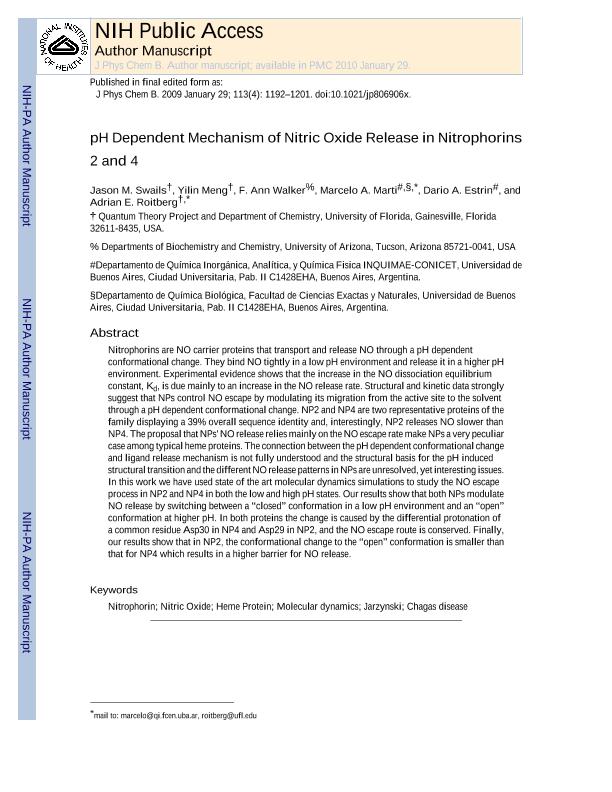Artículo
pH-dependent mechanism of nitric oxide release in nitrophorins 2 and 4
Swails, Jason M.; Meng, Yilin; Walker, F. Ann; Marti, Marcelo Adrian ; Estrin, Dario Ariel
; Estrin, Dario Ariel ; Roitberg, Adrián
; Roitberg, Adrián
 ; Estrin, Dario Ariel
; Estrin, Dario Ariel ; Roitberg, Adrián
; Roitberg, Adrián
Fecha de publicación:
01/2009
Editorial:
American Chemical Society
Revista:
Journal of Physical Chemistry B
ISSN:
1520-6106
Idioma:
Inglés
Tipo de recurso:
Artículo publicado
Clasificación temática:
Resumen
Nitrophorins are NO carrier proteins that transport and release NO through a pH-dependent conformational change. They bind NO tightly in a low pH environment and release it in a higher pH environment. Experimental evidence shows that the increase in the NO dissociation equilibrium constant, K d, is due mainly to an increase in the NO release rate. Structural and kinetic data strongly suggest that NPs control NO escape by modulating its migration from the active site to the solvent through a pH-dependent conformational change. NP2 and NP4 are two representative proteins of the family displaying a 39% overall sequence identity, and interestingly, NP2 releases NO slower than NP4. The proposal that NPs' NO release relies mainly on the NO escape rate makes NPs a very peculiar case among typical heme proteins. The connection between the pH-dependent conformational change and ligand release mechanism is not fully understood and the structural basis for the pH induced structural transition and the different NO release patterns in NPs are unresolved, yet interesting issues. In this work, we have used state of the art molecular dynamics simulations to study the NO escape process in NP2 and NP4 in both the low and high pH states. Our results show that both NPs modulate NO release by switching between a "closed" conformation in a low pH environment and an "open" conformation at higher pH. In both proteins, the change is caused by the differential protonation of a common residue Asp30 in NP4 and Asp29 in NP2, and the NO escape route is conserved. Finally, our results show that, in NP2, the conformational change to the "open" conformation is smaller than that for NP4 which results in a higher barrier for NO release.
Palabras clave:
Nitrophorin
,
Molecular Dynamics
,
Nitric Oxide
,
Heme Protein
,
Chagas Disease
Archivos asociados
Licencia
Identificadores
Colecciones
Articulos(INQUIMAE)
Articulos de INST.D/QUIM FIS D/L MATERIALES MEDIOAMB Y ENERGIA
Articulos de INST.D/QUIM FIS D/L MATERIALES MEDIOAMB Y ENERGIA
Citación
Swails, Jason M.; Meng, Yilin; Walker, F. Ann; Marti, Marcelo Adrian; Estrin, Dario Ariel; et al.; pH-dependent mechanism of nitric oxide release in nitrophorins 2 and 4; American Chemical Society; Journal of Physical Chemistry B; 113; 4; 1-2009; 1192-1201
Compartir
Altmétricas



